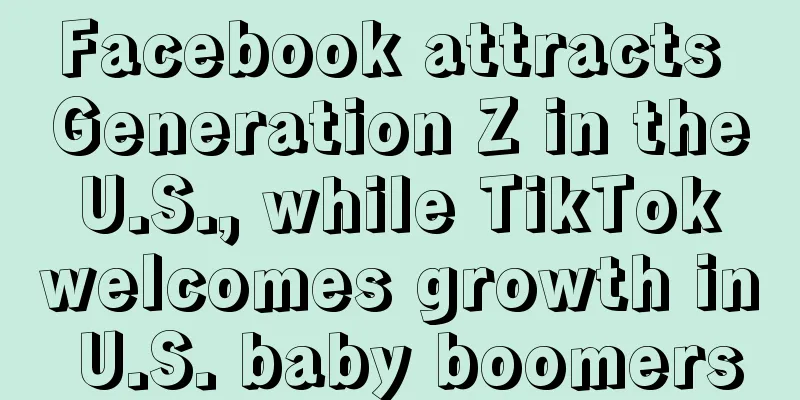Facebook attracts Generation Z in the U.S., while TikTok welcomes growth in U.S. baby boomers

|
According to the latest eMarketer US consumer report, Facebook is regaining the favor of Generation Z users, while TikTok's appeal among baby boomers is gradually increasing. These changes show that although both platforms have a solid core user base, they are also welcoming new users. Facebook's Generation Z Growth Although the number of Facebook users as a whole has declined, the number of Generation Z users has unexpectedly increased. It is expected that by 2028, the proportion of Generation Z users in the United States will increase from 49.0% (33.9 million) in 2024 to 56.9% (40.5 million). A series of key driving factors are reflected in the following aspects : ①Platform practicality: event planning, niche groups and markets attract young users. ② Transformation of user groups: About 36% of Generation Z are still under the age of 18, and many of them are just entering the field of social media. ③ Strong e-commerce potential: Last year, 75.0% of Generation Z Facebook users (15-26 years old) shopped on Marketplace. However, Gen Z still lags behind Gen X and Millennials in terms of the number of users and time spent on Facebook. In addition, users under 55 are also spending less time on Facebook. For Facebook marketers, the growing Gen Z user base presents new opportunities, especially in the e-commerce aspect of Marketplace. However, users are spending less and less time on the platform, which means that brand posts need to be more attractive and targeted. TikTok 's growing appeal to baby boomers Meanwhile, TikTok is saturating its Gen Z market but seeing growth among baby boomers, with forecasts showing U.S. baby boomer users will increase 10.5% by next year, from 8.7 million to 9.7 million. While baby boomers are the fastest-growing demographic group, TikTok usage is rising steadily across generations, indicating the platform’s broad appeal. TikTok’s growth among baby boomers opens up new avenues for brands targeting an aging population, but marketers should be mindful of the platform’s largely younger user base. Future challenges and strategic implications for brands As platforms and users continue to change, brands must adapt or risk being overtaken by competitors, which also presents new challenges and strategic implications for brand marketers: ① Audit strategy: Check the attractiveness of post content across age groups and platforms. ② Diversification: While maintaining brand characteristics, collect statistics and develop multi-faceted marketing strategies for different populations. ③ Group analysis: Track participation by age group and adjust strategies. ④Test and optimize: Experiment with the content and style of each platform. ⑤Stay up to date: Pay attention to platform updates and population trends to stay updated. Stay flexible and update your strategy as user demographics and preferences change. Brands that can span generations and respect the norms of specific platforms are most likely to achieve the greatest success in this ever-changing environment. Author✎ Summer/ |
<<: Amazon's baby swings are recalled by the CPSC for violating multiple safety regulations
>>: Walmart holds 37% of U.S. online grocery market share in Q2, a record high
Recommend
These 6 brands use it to improve customer experience and increase store conversion rates
Today I’d like to introduce a payment method: Ama...
After three years of working alone, I finally found a hot product! How do you monitor the inventory and increase it at the right time? How can you prepare the stock to prevent this product from being out of stock and continue to be popular?
Anonymous user My C position Let me start with the...
What is ProdSG (Product Safety Law)? ProdSG (Product Safety Law) Review
ProdSG is a revised version of the Equipment and P...
【Find Logistics】Enterprise Entry Channel
【Find Logistics】Enterprise Entry Channel " &q...
What is rareteacompany? rareteacompany review
rareteacompany is an independent company based in ...
What is VDE? VDE Review
VDE stands for VDE Testing and Certification Insti...
What to do if Amazon product sales suddenly drop?
There are two reasons for the sudden drop in Amaz...
Tens of thousands of stocks were forced to be removed! Amazon made a shocking operational error
I believe that no matter what you do, you will mee...
Expert Q&A Session: Summary of Amazon FBA Seller Questions
What are the most common questions asked by Amazon...
Will the UK tax-inclusive FBA service be cancelled? Logistics and shipping costs have risen three times!
Recently, rumors that "freight forwarders hav...
Two more express delivery companies have introduced peak season surcharges! Sellers are having a hard time!
<span data-docs-delta="[[20,"获悉,据外媒报道,继USP...
What is Privalia? Privalia Review
Privalia is the No. 1 online fashion exporter in S...
Top 10 characteristics of consumers’ online shopping behavior in 2019
The way people socialize, get news, and shop has ...
Costs skyrocketed before Prime Day: logistics costs for a single site increased by 80,000, and advertising costs increased by 50%
After the Dragon Boat Festival, another festival i...
Banning sales, removing products from shelves, and blocking accounts! Amazon issued three latest rectification policies
Before Membership Day Amazon continues to rectify ...









